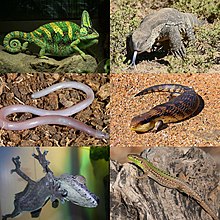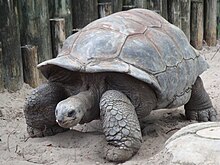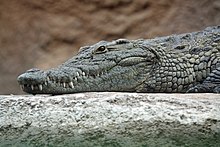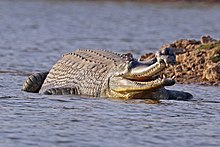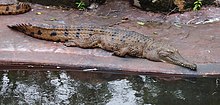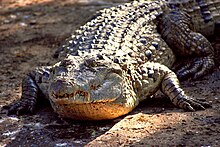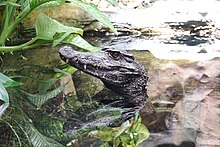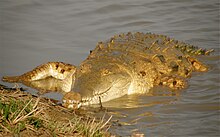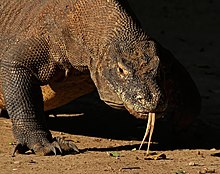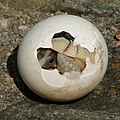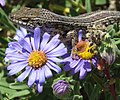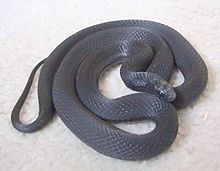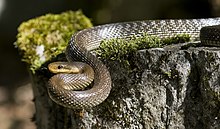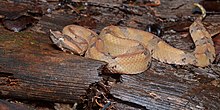Portal:Reptiles
This is an old revision of this page, as edited by The Transhumanist (talk | contribs) at 06:11, 20 July 2018. The present address (URL) is a permanent link to this revision, which may differ significantly from the current revision.
Portal maintenance status: (June 2018)
|
Inroduction
Reptiles, as commonly defined, are a group of tetrapods with an ectothermic ('cold-blooded') metabolism and amniotic development. Living reptiles comprise four orders: Testudines (turtles), Crocodilia (crocodilians), Squamata (lizards and snakes), and Rhynchocephalia (the tuatara). As of May 2023, about 12,000 living species of reptiles are listed in the Reptile Database. The study of the traditional reptile orders, customarily in combination with the study of modern amphibians, is called herpetology.
Reptiles have been subject to several conflicting taxonomic definitions. In Linnaean taxonomy, reptiles are gathered together under the class Reptilia (/rɛpˈtɪliə/ rep-TIL-ee-ə), which corresponds to common usage. Modern cladistic taxonomy regards that group as paraphyletic, since genetic and paleontological evidence has determined that birds (class Aves), as members of Dinosauria, are more closely related to living crocodilians than to other reptiles, and are thus nested among reptiles from an evolutionary perspective. Many cladistic systems therefore redefine Reptilia as a clade (monophyletic group) including birds, though the precise definition of this clade varies between authors. Others prioritize the clade Sauropsida, which typically refers to all amniotes more closely related to modern reptiles than to mammals.
The earliest known proto-reptiles originated from the Carboniferous period, having evolved from advanced reptiliomorph tetrapods which became increasingly adapted to life on dry land. The earliest known eureptile ("true reptile") was Hylonomus, a small and superficially lizard-like animal which lived in Nova Scotia during the Bashkirian age of the Late Carboniferous, around 318 million years ago. Genetic and fossil data argues that the two largest lineages of reptiles, Archosauromorpha (crocodilians, birds, and kin) and Lepidosauromorpha (lizards, and kin), diverged during the Permian period. In addition to the living reptiles, there are many diverse groups that are now extinct, in some cases due to mass extinction events. In particular, the Cretaceous–Paleogene extinction event wiped out the pterosaurs, plesiosaurs, and all non-avian dinosaurs alongside many species of crocodyliforms and squamates (e.g., mosasaurs). Modern non-bird reptiles inhabit all the continents except Antarctica. (Full article...)
Reptile types
-
Image 1Clockwise from top left: veiled chameleon (Chamaeleo calyptratus), rock monitor (Varanus albigularis), common blue-tongued skink (Tiliqua scincoides), Italian wall lizard (Podarcis sicula), giant leaf-tailed gecko (Uroplatus fimbriatus), and legless lizard (Anelytropsis papillosus)
Lizard is the common name used for all squamate reptiles other than snakes (and to a lesser extent amphisbaenians), encompassing over 7,000 species, ranging across all continents except Antarctica, as well as most oceanic island chains. The grouping is paraphyletic as some lizards are more closely related to snakes than they are to other lizards. Lizards range in size from chameleons and geckos a few centimeters long to the 3-meter-long Komodo dragon.
Most lizards are quadrupedal, running with a strong side-to-side motion. Some lineages (known as "legless lizards") have secondarily lost their legs, and have long snake-like bodies. Some lizards, such as the forest-dwelling Draco, are able to glide. They are often territorial, the males fighting off other males and signalling, often with bright colours, to attract mates and to intimidate rivals. Lizards are mainly carnivorous, often being sit-and-wait predators; many smaller species eat insects, while the Komodo eats mammals as big as water buffalo.
Lizards make use of a variety of antipredator adaptations, including venom, camouflage, reflex bleeding, and the ability to sacrifice and regrow their tails. (Full article...) -
Image 2Blanus cinereus, Spain
Amphisbaenia /æmfɪsˈbiːniə/ (called amphisbaenians or worm lizards) is a group of typically legless lizards, comprising over 200 extant species. Amphisbaenians are characterized by their long bodies, the reduction or loss of the limbs, and rudimentary eyes. As many species have a pink body and scales arranged in rings, they have a superficial resemblance to earthworms. While the genus Bipes retains forelimbs, all other genera are limbless. Phylogenetic studies suggest that they are nested within Lacertoidea, closely related to the lizard family Lacertidae. Amphisbaenians are widely distributed, occurring in North America, Europe, Africa, South America, Western Asia and the Caribbean. Most species are less than 6 inches (15 cm) long. (Full article...) -
Image 3
Snakes are elongated, limbless reptiles of the suborder Serpentes (/sɜːrˈpɛntiːz/). Like all other squamates, snakes are ectothermic, amniote vertebrates covered in overlapping scales. Many species of snakes have skulls with several more joints than their lizard ancestors, enabling them to swallow prey much larger than their heads (cranial kinesis). To accommodate their narrow bodies, snakes' paired organs (such as kidneys) appear one in front of the other instead of side by side, and most have only one functional lung. Some species retain a pelvic girdle with a pair of vestigial claws on either side of the cloaca. Lizards have independently evolved elongate bodies without limbs or with greatly reduced limbs at least twenty-five times via convergent evolution, leading to many lineages of legless lizards. These resemble snakes, but several common groups of legless lizards have eyelids and external ears, which snakes lack, although this rule is not universal (see Amphisbaenia, Dibamidae, and Pygopodidae).
Living snakes are found on every continent except Antarctica, and on most smaller land masses; exceptions include some large islands, such as Ireland, Iceland, Greenland, and the islands of New Zealand, as well as many small islands of the Atlantic and central Pacific oceans. Additionally, sea snakes are widespread throughout the Indian and Pacific oceans. Around thirty families are currently recognized, comprising about 520 genera and about 3,900 species. They range in size from the tiny, 10.4 cm-long (4.1 in) Barbados threadsnake to the reticulated python of 6.95 meters (22.8 ft) in length. The fossil species Titanoboa cerrejonensis was 12.8 meters (42 ft) long. Snakes are thought to have evolved from either burrowing or aquatic lizards, perhaps during the Jurassic period, with the earliest known fossils dating to between 143 and 167 Ma ago. The diversity of modern snakes appeared during the Paleocene epoch (c. 66 to 56 Ma ago, after the Cretaceous–Paleogene extinction event). The oldest preserved descriptions of snakes can be found in the Brooklyn Papyrus.
Most species of snake are nonvenomous and those that have venom use it primarily to kill and subdue prey rather than for self-defense. Some possess venom that is potent enough to cause painful injury or death to humans. Nonvenomous snakes either swallow prey alive or kill by constriction. (Full article...) -
Image 4Yacare caiman, Caiman yacare
A caiman (/ˈkeɪmən/ (also spelled cayman) from Taíno kaiman[additional citation(s) needed]) is an alligatorid belonging to the subfamily Caimaninae, one of two primary lineages within the Alligatoridae family, the other being alligators. Caimans are native to Central and South America and inhabit marshes, swamps, lakes, and mangrove rivers. They have scaly skin and live a fairly nocturnal existence. They are relatively small-sized crocodilians with an average maximum weight of 6 to 40 kg (13 to 88 lb) depending on species, with the exception of the black caiman (Melanosuchus niger), which can grow more than 4 m (13 ft) in length and weigh in excess of 450 kg (1,000 Ib). The black caiman is the largest caiman species in the world and is found in the slow-moving rivers and lakes that surround the Amazon basin. The smallest species is the Cuvier's dwarf caiman (Paleosuchus palpebrosus), which grows to 1.2 to 1.5 m (3.9 to 4.9 ft) long. There are six different species of caiman found throughout the watery jungle habitats of Central and Southern America. The average length for most of the other caiman species is about 2 to 2.5 m (6.6 to 8.2 ft) long.
Caimans are distinguished from alligators, their closest relatives, by a few defining features: a lack of a bony septum between the nostrils, ventral armor composed of overlapping bony scutes formed from two parts united by a suture, and longer and sharper teeth than alligators, plus caimans tend to be more agile and crocodile-like in their movements. The calcium rivets on caiman scales make their hides stiffer.
Several extinct forms are known, including Purussaurus, a giant Miocene genus that grew to 12 m (39 ft) and the equally large Mourasuchus, which had a wide duck-like snout. (Full article...) -
Image 5Aldabra giant tortoise
(Aldabrachelys gigantea)
Tortoises (/ˈtɔːrtəs.ɪz/ TOR-təs-iz) are reptiles of the family Testudinidae of the order Testudines (Latin for "tortoise"). Like other turtles, tortoises have a shell to protect from predation and other threats. The shell in tortoises is generally hard, and like other members of the suborder Cryptodira, they retract their necks and heads directly backward into the shell to protect them.
Tortoises can vary in size with some species, such as the Galápagos giant tortoise, growing to more than 1.2 metres (3.9 ft) in length, whereas others like the Speckled cape tortoise have shells that measure only 6.8 centimetres (2.7 in) long. Several lineages of tortoises have independently evolved very large body sizes in excess of 100 kg, including the Galapagos giant tortoise and the Aldabra giant tortoise. They are usually diurnal animals with tendencies to be crepuscular depending on the ambient temperatures. They are generally reclusive animals. Tortoises are the longest-living land animals in the world, although the longest-living species of tortoise is a matter of debate. Galápagos tortoises are noted to live over 150 years, but an Aldabra giant tortoise named Adwaita may have lived an estimated 255 years. In general, most tortoise species can live 80–150 years.
Tortoises are placid and slow-moving, with an average walking speed of 0.2–0.5 km/h.[citation needed] (Full article...) -
Image 6Nile crocodile (Crocodylus niloticus)
Crocodiles (family Crocodylidae) or true crocodiles are large semiaquatic reptiles that live throughout the tropics in Africa, Asia, the Americas and Australia. The term crocodile is sometimes used even more loosely to include all extant members of the order Crocodilia, which includes the alligators and caimans (family Alligatoridae), the gharial and false gharial (family Gavialidae) among other extinct taxa.
Although they appear similar, crocodiles, alligators and the gharial belong to separate biological families. The gharial, with its narrow snout, is easier to distinguish, while morphological differences are more difficult to spot in crocodiles and alligators. The most obvious external differences are visible in the head, with crocodiles having narrower and longer heads, with a more V-shaped than a U-shaped snout compared to alligators and caimans. Another obvious trait is that the upper and lower jaws of the crocodiles are the same width, and the teeth in the lower jaw fall along the edge or outside the upper jaw when the mouth is closed; therefore, all teeth are visible, unlike an alligator, which possesses in the upper jaw small depressions into which the lower teeth fit. Also, when the crocodile's mouth is closed, the large fourth tooth in the lower jaw fits into a constriction in the upper jaw. For hard-to-distinguish specimens, the protruding tooth is the most reliable feature to define the species' family. Crocodiles have more webbing on the toes of the hind feet and can better tolerate saltwater due to specialized salt glands for filtering out salt, which are present, but non-functioning, in alligators. Another trait that separates crocodiles from other crocodilians is their much higher levels of aggression.
Crocodile size, morphology, behaviour and ecology differ somewhat among species. However, they have many similarities in these areas as well. All crocodiles are semiaquatic and tend to congregate in freshwater habitats such as rivers, lakes, wetlands and sometimes in brackish water and saltwater. They are carnivorous animals, feeding mostly on vertebrates such as fish, reptiles, birds and mammals, and sometimes on invertebrates such as molluscs and crustaceans, depending on species and age. All crocodiles are tropical species that, unlike alligators, are very sensitive to cold. They separated from other crocodilians during the Eocene epoch, about 55 million years ago. Many species are at the risk of extinction, some being classified as critically endangered. (Full article...) -
Image 7An American alligator (top) and a Chinese alligator
An alligator, or colloquially gator, is a large reptile in the genus Alligator of the family Alligatoridae of the order Crocodilia. The two extant species are the American alligator (A. mississippiensis) and the Chinese alligator (A. sinensis). Additionally, several extinct species of alligator are known from fossil remains. Alligators first appeared during the late Eocene epoch about 37 million years ago.
The name "alligator" is likely an anglicized form of el lagarto, the Spanish term for "the lizard", which early Spanish explorers and settlers in Florida called the alligator. Early English spellings of the name included allagarta and alagarto. (Full article...) -
Image 8
The tuatara (Sphenodon punctatus) is a species of reptile endemic to New Zealand. Despite its close resemblance to lizards, it is part of a distinct lineage, the order Rhynchocephalia. The name tuatara is derived from the Māori language and means "peaks on the back".
The single extant species of tuatara is the only surviving member of its order, which was highly diverse during the Mesozoic era. Rhynchocephalians first appeared in the fossil record during the Triassic, around 240 million years ago, and reached worldwide distribution and peak diversity during the Jurassic, when they represented the world's dominant group of small reptiles. Rhynchocephalians underwent a great decline during the Cretaceous with their youngest records outside New Zealand dating to the Paleocene. Their closest living relatives are squamates (lizards and snakes). Tuatara are of interest for studying the evolution of reptiles.
Tuatara are greenish brown and grey, and measure up to 80 cm (31 in) from head to tail-tip and weigh up to 1.3 kg (2.9 lb) with a spiny crest along the back, especially pronounced in males. They have two rows of teeth in the upper jaw overlapping one row on the lower jaw, which is unique among living species. They are able to hear, although no external ear is present, and have unique features in their skeleton. (Full article...) -
Image 9
The gharial (Gavialis gangeticus), also known as gavial or fish-eating crocodile, is a crocodilian in the family Gavialidae and among the longest of all living crocodilians. Mature females are 2.6 to 4.5 m (8 ft 6 in to 14 ft 9 in) long, and males 3 to 6 m (9 ft 10 in to 19 ft 8 in). Adult males have a distinct boss at the end of the snout, which resembles an earthenware pot known as a ghara, hence the name "gharial". The gharial is well adapted to catching fish because of its long, narrow snout and 110 sharp, interlocking teeth.
The gharial probably evolved in the northern Indian subcontinent. Fossil gharial remains were excavated in Pliocene deposits in the Sivalik Hills and the Narmada River valley. It currently inhabits rivers in the plains of the northern part of the Indian subcontinent. It is the most thoroughly aquatic crocodilian, and leaves the water only for basking and building nests on moist sandbanks. Adults mate at the end of the cold season. Females congregate in spring to dig nests, in which they lay 20–95 eggs. They guard the nests and the young, which hatch before the onset of the monsoon. The hatchlings stay and forage in shallow water during their first year, but move to sites with deeper water as they grow.
The wild gharial population has declined drastically since the 1930s and is limited to only 2% of its historical range today. Conservation programmes initiated in India and Nepal focused on reintroducing captive-bred gharials since the early 1980s. Loss of habitat because of sand mining and conversion to agriculture, depletion of fish resources and detrimental fishing methods continue to threaten the population. It has been listed as critically endangered on the IUCN Red List since 2007. (Full article...) -
Image 10
Turtles are reptiles of the order Testudines, characterized by a special shell developed mainly from their ribs. Modern turtles are divided into two major groups, the Pleurodira (side necked turtles) and Cryptodira (hidden necked turtles), which differ in the way the head retracts. There are 360 living and recently extinct species of turtles, including land-dwelling tortoises and freshwater terrapins. They are found on most continents, some islands and, in the case of sea turtles, much of the ocean. Like other amniotes (reptiles, birds, and mammals) they breathe air and do not lay eggs underwater, although many species live in or around water.
Turtle shells are made mostly of bone; the upper part is the domed carapace, while the underside is the flatter plastron or belly-plate. Its outer surface is covered in scales made of keratin, the material of hair, horns, and claws. The carapace bones develop from ribs that grow sideways and develop into broad flat plates that join up to cover the body. Turtles are ectotherms or "cold-blooded", meaning that their internal temperature varies with their direct environment. They are generally opportunistic omnivores and mainly feed on plants and animals with limited movements. Many turtles migrate short distances seasonally. Sea turtles are the only reptiles that migrate long distances to lay their eggs on a favored beach.
Turtles have appeared in myths and folktales around the world. Some terrestrial and freshwater species are widely kept as pets. Turtles have been hunted for their meat, for use in traditional medicine, and for their shells. Sea turtles are often killed accidentally as bycatch in fishing nets. Turtle habitats around the world are being destroyed. As a result of these pressures, many species are extinct or threatened with extinction. (Full article...)
Selected Crocodilia articles
-
Image 1

The mugger crocodile (Crocodylus palustris) is a medium-sized broad-snouted crocodile, also known as mugger and marsh crocodile. It is native to freshwater habitats from southern Iran to the Indian subcontinent, where it inhabits marshes, lakes, rivers and artificial ponds. It rarely reaches a body length of 5 m (16 ft 5 in) and is a powerful swimmer, but also walks on land in search of suitable waterbodies during the hot season. Both young and adult mugger crocodiles dig burrows to which they retreat when the ambient temperature drops below 5 °C (41 °F) or exceeds 38 °C (100 °F). Females dig holes in the sand as nesting sites and lay up to 46 eggs during the dry season. The sex of hatchlings depends on temperature during incubation. Both parents protect the young for up to one year. They feed on insects, and adults prey on fish, reptiles, birds and mammals.
The mugger crocodile evolved at least 4.19 million years ago and has been a symbol for the fructifying and destructive powers of the rivers since the Vedic period. It was first scientifically described in 1831 and is protected by law in Iran, India and Sri Lanka. Since 1982, it has been listed as Vulnerable on the IUCN Red List. Outside protected areas, it is threatened by conversion of natural habitats, gets entangled in fishing nets and is killed in human–wildlife conflict situations and in traffic accidents. (Full article...) -
Image 2At Le Bonheur Crocodile Farm near Stellenbosch, South Africa
The Nile crocodile (Crocodylus niloticus) is a large crocodilian native to freshwater habitats in Africa, where it is present in 26 countries. It is widely distributed in sub-Saharan Africa, occurring mostly in the eastern, southern, and central regions of the continent, and lives in different types of aquatic environments such as lakes, rivers, swamps and marshlands. It occasionally inhabits deltas, brackish lakes and rarely also saltwater. Its range once stretched from the Nile Delta throughout the Nile River. Lake Turkana in Kenya has one of the largest undisturbed Nile crocodile populations.
Generally, the adult male Nile crocodile is between 3.5 and 5 m (11 ft 6 in and 16 ft 5 in) in length and weighs 225 to 750 kg (496 to 1,653 lb). However, specimens exceeding 6.1 m (20 ft) in length and 1,000 kg (2,200 lb) in weight have been recorded. It is the largest predator in Africa, and may be considered the second-largest extant reptile in the world, after the saltwater crocodile (Crocodylus porosus). Size is sexually dimorphic, with females usually about 30% smaller than males. The crocodile has thick, scaly, heavily armoured skin.
Nile crocodiles are opportunistic apex predators; a very aggressive crocodile, they are capable of taking almost any animal within their range. They are generalists, taking a variety of prey, with a diet consisting mostly of different species of fish, reptiles, birds, and mammals. As ambush predators, they can wait for hours, days, and even weeks for the suitable moment to attack. They are agile predators and wait for the opportunity for a prey item to come well within attack range. Even swift prey are not immune to attack. Like other crocodiles, Nile crocodiles have a powerful bite that is unique among all animals, and sharp, conical teeth that sink into flesh, allowing a grip that is almost impossible to loosen. They can apply high force for extended periods of time, a great advantage for holding down large prey underwater to drown. (Full article...) -
Image 3At La Manzanilla, Jalisco, Mexico
The American crocodile (Crocodylus acutus) is a species of crocodilian found in the Neotropics. It is the most widespread of the four extant species of crocodiles from the Americas, with populations present from South Florida, the Caribbean islands of Cuba, Jamaica, Hispaniola, and the coasts of Mexico to as far south as Peru, Ecuador, Colombia, and Venezuela.
The habitat of the American crocodile consists largely of coastal areas. It is also found in river systems, but tends to prefer salinity, resulting in the species congregating in brackish lakes, mangrove swamps, lagoons, cays, and small islands. Other crocodiles also have tolerance to saltwater due to salt glands underneath the tongue, but the American crocodile is the only species other than the saltwater crocodile to commonly live and thrive in saltwater. They can be found on beaches and small island formations without any freshwater source, such as many cays and islets across the Caribbean. They are also found in hypersaline lakes; one of the largest known populations inhabits Lago Enriquillo in the Dominican Republic.
The American crocodile is one of the largest crocodile species. Males can reach lengths of more than 6.1 m (20 ft 0 in), weighing over 1,000 kilograms (2,200 lb). On average, mature males are more in the range of 2.9 to 4.1 m (9 ft 6 in to 13 ft 5 in) in length weighing up to about 400 kg (880 lb). As with other crocodile species, females are smaller, rarely exceeding 3.8 m (12 ft 6 in) in length even in the largest-bodied population. (Full article...) -
Image 4

The Chinese alligator (Alligator sinensis; simplified Chinese: 鼍; traditional Chinese: 鼉; pinyin: tuó), also known as the Yangtze alligator (simplified Chinese: 扬子鳄; traditional Chinese: 揚子鱷; pinyin: yángzǐ'è), China alligator, or historically the muddy dragon, is a crocodilian endemic to China. It and the American alligator (A. mississippiensis) are the only living species in the genus Alligator of the family Alligatoridae. Dark gray or black in color with a fully armored body, the Chinese alligator grows to 1.5–2.1 metres (5–7 ft) in length and weighs 36–45 kilograms (80–100 lb) as an adult. It brumates in burrows in winter and is nocturnal in summer. Mating occurs in early summer, with females most commonly producing 20–30 eggs, which are smaller than those of any other crocodilian. The species is an opportunistic feeder, primarily eating fish and invertebrates. A vocal species, adults bellow during the mating season and young vocalize to communicate with their parents and other juveniles. Captive specimens have reached age 70, and wild specimens can live past 50.
Living in bodies of fresh water, the Chinese alligator's range is restricted to six regions in the province of Anhui, as well as possibly the provinces of Jiangsu and Zhejiang. Originally living as far away from its current range as Japan, the species previously had a wide range and population, but beginning in 6000 BC, multiple threats, such as habitat destruction, caused the species' population and range to decline. The population in the wild was about 1,000 in the 1970s, decreased to below 130 in 2001, and grew after 2003, with its population being about 300 as of 2017. Listed as critically endangered by the International Union for Conservation of Nature, multiple conservation actions have been taking place for this species.
The Chinese alligator has been a part of Chinese literature since the third century. In the late 13th century, Marco Polo became the first person outside of China to write about it. In some writings, the Chinese alligator has been associated with the Chinese dragon. Many pieces of evidence suggest that the Chinese alligator was an inspiration for the Chinese dragon. (Full article...) -
Image 5
Mecistops is a genus of crocodiles, the slender-snouted crocodiles, native to sub-Saharan Africa. (Full article...) -
Image 6
The dwarf crocodile (Osteolaemus tetraspis), also known as the African dwarf crocodile, broad-snouted crocodile (a name more often used for the Asian mugger crocodile) or bony crocodile, is an African crocodile that is also the smallest extant (living) species of crocodile. (Full article...) -
Image 7
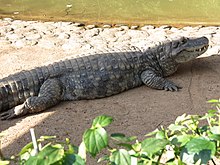
The broad-snouted caiman (Caiman latirostris) is a crocodilian in the family Alligatoridae found in eastern and central South America, including the Pantanal habitat of Bolivia, Southeast Brazil, and Paraguay, as well as northern Argentina and Uruguay. Behind the black caiman (Melanosuchus niger), it is the second-largest caiman species; it is the third-largest alligatorid behind the American alligator (Alligator mississippiensis) and the aforementioned black caiman. Primarily, the species inhabits freshwater wetlands, including floodplains, marshes, swamps, and some mangrove forests, as well as various streams, rivers, lakes or ponds, preferring bodies of rather still or slower-moving water. They will often utilize man-made cow ponds, disused stock tanks, and canals and ditches, as well. (Full article...) -
Image 8New Guinea crocodile at Bandung Zoo in West Java, Indonesia
The New Guinea crocodile (Crocodylus novaeguineae) is a small species of crocodile found on the island of New Guinea north of the mountain ridge that runs along the centre of the island. The population found south of the mountain ridge, formerly considered a genetically distinct population, is now considered a distinct species, Hall's New Guinea crocodile (C. halli). In the past it included the Philippine crocodile, C. n. mindorensis, as a subspecies, but today they are regarded as separate species. The habitat of the New Guinea crocodile is mostly freshwater swamps and lakes. It is most active at night when it feeds on fish and a range of other small animals. A female crocodile lays a clutch of eggs in a nest composed of vegetation and she lies up nearby to guard the nest. There is some degree of parental care for newly hatched juveniles. This crocodile was over-hunted for its valuable skin in the mid 20th century, but conservation measures have since been put in place, it is reared in ranches and the International Union for Conservation of Nature (IUCN) lists it as being of "Least Concern". (Full article...) -
Image 9
The freshwater crocodile (Crocodylus johnstoni), also known commonly as the Australian freshwater crocodile, Johnstone's crocodile, and the freshie, is a species of crocodile native to the northern regions of Australia. Unlike its much larger Australian relative, the saltwater crocodile, the freshwater crocodile is not known as a man-eater, although it bites in self-defence, and brief, nonfatal attacks have occurred, apparently the result of mistaken identity. (Full article...) -
Image 10An adult basking on the island of Palawan, Philippines
The Philippine crocodile (Crocodylus mindorensis), also known as the Mindoro crocodile, the Philippine freshwater crocodile, the bukarot in Ilocano, and more generally as a buwaya in most Filipino lowland cultures, is one of two species of crocodiles found in the Philippines; the other is the larger saltwater crocodile (Crocodylus porosus). The Philippine crocodile, the species endemic only to the country, went from data deficient to critically endangered in 2008 from exploitation and unsustainable fishing methods, such as dynamite fishing. Conservation methods are being taken by the Dutch/Filipino Mabuwaya foundation, the Crocodile Conservation Society and the Zoological Institute of HerpaWorld in Mindoro island. It is strictly prohibited to kill a crocodile in the country, and it is punishable by law. (Full article...) -
Image 11

The black caiman (Melanosuchus niger) is a crocodilian reptile endemic to South America. With a maximum length of around 5 to 6 m (16 to 20 ft) and a mass of over 450 kg (1,000 lb), it is the largest living species of the family Alligatoridae, and the third-largest crocodilian in the Neotropical realm. True to its common and scientific names, the black caiman has a dark greenish-black coloration as an adult. In some individuals, the pigmentation can appear almost jet-black. It has grey to brown banding on the lower jaw; juveniles have a more vibrant coloration compared to adults, with prominent white-pale yellow banding on the flanks that remains present well into adulthood (more than most other species). The banding on young animals helps with camouflage by breaking up their body outline, on land or in water, in an effort to avoid predation. The morphology is quite different from other caimans but the bony ridge that occurs in other caimans is present. The head is large and heavy, an advantage in catching larger prey. Like all crocodilians, caimans are long, squat creatures, with big jaws, long tails and short legs. They have thick, scaled skin, and their eyes and noses are located on the tops of their heads. This enables them to see and breathe while the rest of their bodies are underwater.
A carnivorous animal, the black caiman lives along freshwater habitats, including slow-moving rivers, lakes and seasonally flooded savannas, where it preys upon a variety of fish, reptiles, birds, and mammals. Being an apex predator and potentially a keystone species, it is generalist, capable of taking most animals within its range, and might have played a critical role in maintaining structure of the ecosystem. Although merely few specific ecological studies have been conducted, it is observed that this species has its own niche which allows coexistence with other competitors.
Reproduction takes place in the dry season. Females build a nest mound with an egg chamber, protecting the eggs from predators. Hatchlings form groups called pods, guarded by the presence of the female. These pods may contain individuals from other nests. Once common, it was hunted to near extinction primarily for its commercially valuable hide. It is now making a comeback, listed as Conservation Dependent. Overall a little-known species, it was not researched in any detail until the 1980s, when the leather-trade had already taken its toll. It is a dangerous species to humans, and attacks have occurred in the past. (Full article...) -
Image 12At Zapata Swamp, Matanzas Province, Cuba
The Cuban crocodile (Crocodylus rhombifer) is a small-medium species of crocodile endemic to Cuba. Typical length is 2.1–2.3 m (6.9–7.5 ft) and typical weight 70–80 kg (150–180 lb). Large males can reach as much as 3.5 m (11 ft) in length and weigh more than 215 kg (474 lb). Despite its smaller size, it is a highly aggressive animal (one of the most territorial of all crocodilians), and potentially dangerous to humans.
The Cuban crocodile is of interest to biologists for its unique physical and behavioral traits. Long- and strong-legged, it is the most terrestrial of extant crocodiles. Its preferred habitat comprises freshwater and brackish water environments, such as mangrove swamps, coastal lagoons, estuaries, marshes, floodplains, and river deltas. There, the adults feed on fish, turtles and small mammals, while the young eat invertebrates and smaller fish. Mating occurs between May and July. Captive animals have displayed cooperative hunting behavior, and can be taught tricks, suggesting intelligence.
The Cuban crocodile is listed as Critically Endangered by the International Union for Conservation of Nature. Once spread across the Caribbean, its range has dwindled to including only the Zapata Swamp and Isla de la Juventud, due to hunting by humans. Captive breeding projects are in place to help the species recover.
The species fossil record reveals it had at one point a greater range, with fossil remains being found in The Bahamas, Hispaniola (in the Dominican Republic), and the Cayman Islands. (Full article...) -
Image 13At the Columbus Zoo and Aquarium in Powell, Ohio
The American alligator (Alligator mississippiensis), sometimes referred to as a gator, or common alligator is a large crocodilian reptile native to the Southeastern United States and a small section of northeastern Mexico. It is one of the two extant species in the genus Alligator, and is larger than the only other living alligator species, the Chinese alligator.
Adult male American alligators measure 3.4 to 4.6 m (11.2 to 15.1 ft) in length, and can weigh up to 500 kg (1,100 lb), with unverified sizes of up to 5.84 m (19.2 ft) and weights of 1,000 kg (2,200 lb) making it the second largest member by length and the heaviest of the family Alligatoridae, after the black caiman. Females are smaller, measuring 2.6 to 3 m (8.5 to 9.8 ft) in length. The American alligator inhabits subtropical and tropical freshwater wetlands, such as marshes and cypress swamps, from southern Texas to North Carolina. It is distinguished from the sympatric American crocodile by its broader snout, with overlapping jaws and darker coloration, and is less tolerant of saltwater but more tolerant of cooler climates than the American crocodile, which is found only in tropical and warm subtropical climates.
American alligators are apex predators and consume fish, amphibians, reptiles, birds, and mammals. Hatchlings feed mostly on invertebrates. They play an important role as ecosystem engineers in wetland ecosystems through the creation of alligator holes, which provide both wet and dry habitats for other organisms. Throughout the year (in particular during the breeding season), American alligators bellow to declare territory, and locate suitable mates. Male American alligators use infrasound to attract females. Eggs are laid in a nest of vegetation, sticks, leaves, and mud in a sheltered spot in or near the water. Young are born with yellow bands around their bodies and are protected by their mother for up to one year. This species displays parental care, which is rare for most reptiles. Mothers protect their eggs during the incubation period, and moves the hatchlings to the water using her mouth. (Full article...) -
Image 14

Morelet's crocodile (Crocodylus moreletii), also known as the Mexican crocodile or Belize crocodile, is a modest-sized crocodilian found only in the Atlantic regions of Mexico, Belize and Guatemala. It usually grows to about 3 metres (10 ft) in length. It is a species at least concern for extinction according to the International Union for Conservation of Nature.
The species has a fossil record in Guatemala. (Full article...) -
Image 15
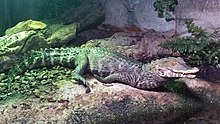
Cuvier's dwarf caiman (Paleosuchus palpebrosus) is a small crocodilian in the alligator family from northern and central South America. It is found in Bolivia, Brazil, Colombia, Ecuador, French Guiana, Guyana, Paraguay, Peru, Suriname, Trinidad and Venezuela. It lives in riverine forests, flooded forests near lakes, and near fast-flowing rivers and streams. It can traverse dry land to reach temporary pools and tolerates colder water than other species of caimans. Other common names for this species include the musky caiman, the dwarf caiman, Cuvier's caiman, and the smooth-fronted caiman (the latter name is also used for P. trigonatus). It is sometimes kept in captivity as a pet and may be referred to as the wedge-head caiman by the pet trade community.
Cuvier's dwarf caiman was first described by the French zoologist Georges Cuvier in 1807 and is one of only two species in the genus Paleosuchus, the other species being P. trigonatus. Their closest relatives are the other caimans in the subfamily Caimaninae. With a total length averaging 1.4 m (4.6 ft) for males and up to 1.2 m (3.9 ft) for females, Cuvier's dwarf caiman is not only the smallest extant species in the alligator and caiman family, but also the smallest of all crocodilians (unless the Congo dwarf crocodile is considered a valid species). An adult weighs around 5 to 7 kg (11 to 15 lb). Its lack of size is partly made up for by its strong body armor, provided by the bony bases to its dermal scales, which provides protection against predators. Juvenile dwarf caimans mainly feed on invertebrates, but also small fish and frogs, while adults eat larger fish, amphibians, and invertebrates, such as large molluscs. This caiman sometimes uses a burrow as shelter during the day and in the Pantanal may aestivate in the burrow to stay cool in the dry season. The female buries her eggs on a mounded nest and these take about 3 months to hatch. She helps the hatchlings to escape from the nest and provides some parental care for the first few weeks of their lives. This caiman has a wide range and large total population and the IUCN lists its conservation status as being of least concern. (Full article...) -
Image 16

The saltwater crocodile (Crocodylus porosus) is a crocodilian native to saltwater habitats, brackish wetlands and freshwater rivers from India's east coast across Southeast Asia and the Sundaic region to northern Australia and Micronesia. It has been listed as Least Concern on the IUCN Red List since 1996. It was hunted for its skin throughout its range up to the 1970s, and is threatened by illegal killing and habitat loss. It is regarded as dangerous to humans.
The saltwater crocodile is the largest living reptile. Males can grow up to a weight of 1,000–1,500 kg (2,200–3,300 lb) and a length of 6 m (20 ft), rarely exceeding 6.3 m (21 ft). Females are much smaller and rarely surpass 3 m (9.8 ft). It is also called the estuarine crocodile, Indo-Pacific crocodile, marine crocodile, sea crocodile, and, informally, the saltie. A large and opportunistic hypercarnivorous apex predator, they ambush most of their prey and then drown or swallow it whole. They will prey on almost any animal that enters their territory, including other predators such as sharks, varieties of freshwater and saltwater fish including pelagic species, invertebrates such as crustaceans, various amphibians, other reptiles, birds, and mammals. (Full article...) -
Image 17
The spectacled caiman (Caiman crocodilus), also known as the white caiman, common caiman, and speckled caiman, is a crocodilian in the family Alligatoridae. It is brownish-, greenish-, or yellowish-gray colored and has a spectacle-like ridge between its eyes, which is where its common name come from. It grows to a length of 1.4–2.5 m (4 ft 7 in – 8 ft 2 in) and a weight of 7–40 kg (15–88 lb), with males being both longer and heavier than females. Its diet varies seasonally, commonly consisting of crabs, fish, small mammals, amphibians and snails. Breeding occurs from May to August and 14–40 eggs are laid in July and August. This crocodilian has a large range and population; it is native to much of Latin America, and has been introduced to the United States, Cuba, and Puerto Rico. (Full article...) -
Image 18
The gharial (Gavialis gangeticus), also known as gavial or fish-eating crocodile, is a crocodilian in the family Gavialidae and among the longest of all living crocodilians. Mature females are 2.6 to 4.5 m (8 ft 6 in to 14 ft 9 in) long, and males 3 to 6 m (9 ft 10 in to 19 ft 8 in). Adult males have a distinct boss at the end of the snout, which resembles an earthenware pot known as a ghara, hence the name "gharial". The gharial is well adapted to catching fish because of its long, narrow snout and 110 sharp, interlocking teeth.
The gharial probably evolved in the northern Indian subcontinent. Fossil gharial remains were excavated in Pliocene deposits in the Sivalik Hills and the Narmada River valley. It currently inhabits rivers in the plains of the northern part of the Indian subcontinent. It is the most thoroughly aquatic crocodilian, and leaves the water only for basking and building nests on moist sandbanks. Adults mate at the end of the cold season. Females congregate in spring to dig nests, in which they lay 20–95 eggs. They guard the nests and the young, which hatch before the onset of the monsoon. The hatchlings stay and forage in shallow water during their first year, but move to sites with deeper water as they grow.
The wild gharial population has declined drastically since the 1930s and is limited to only 2% of its historical range today. Conservation programmes initiated in India and Nepal focused on reintroducing captive-bred gharials since the early 1980s. Loss of habitat because of sand mining and conversion to agriculture, depletion of fish resources and detrimental fishing methods continue to threaten the population. It has been listed as critically endangered on the IUCN Red List since 2007. (Full article...) -
Image 19A smooth-fronted caiman at Zoologischer Garten Berlin in Berlin, Germany
The smooth-fronted caiman (Paleosuchus trigonatus), also known as Schneider's dwarf caiman or Schneider's smooth-fronted caiman, is a crocodilian from South America, where it is native to the Amazon and Orinoco Basins. It is the second-smallest species of the family Alligatoridae, the smallest being Cuvier's dwarf caiman, also from tropical South America and in the same genus. An adult typically grows to around 1.2 to 1.6 m (3.9 to 5.2 ft) in length and weighs between 9 and 20 kg (20 and 44 lb). Exceptionally large males can reach as much as 2.3 m (7.5 ft) in length and 36 kg (79 lb) in weight. (Full article...) -
Image 20Specimen in Bazoulé, Burkina Faso
The West African crocodile, desert crocodile, or sacred crocodile (Crocodylus suchus) is a species of crocodile related to, and often confused with, the larger and more aggressive Nile crocodile (C. niloticus). (Full article...) -
Image 21Mato Grosso, Brazil
The yacare caiman (Caiman yacare), also known commonly as the jacare caiman, Paraguayan caiman, piranha caiman, red caiman, and southern spectacled caiman, is a species of caiman, a crocodilian in the family Alligatoridae. The species is endemic to Argentina, Bolivia, Brazil, and Paraguay. Brown in color and covered with dark blotches, males grow to a total length (including tail) of 2–3 m (6 ft 7 in – 9 ft 10 in) and weigh around 40–50 kg (88–110 lb); while females grow to 1.4 m (4 ft 7 in) long and about 15–20 kg (33–44 lb). Typical habitats of this caiman include lakes, rivers, and wetlands. Its diet primarily consists of aquatic animals, such as snails, and occasionally land vertebrates. Mating occurs in the rainy season and eggs hatch in March, with young fending for themselves as soon as they hatch. The yacare caiman was hunted heavily for its skin to use for leather in the 1980s, which caused its population to decrease significantly. However, trading restrictions placed since have caused its population to increase. Its population in the Pantanal is about 10 million, and it is listed as least concern on the IUCN Red List. (Full article...) -
Image 22
The Siamese crocodile (Crocodylus siamensis) is a medium-sized freshwater crocodile native to Indonesia (Borneo and possibly Java), Brunei, East Malaysia, Laos, Cambodia, Myanmar, Thailand and Vietnam. The species is critically endangered and already extirpated from many regions. Its other common names include Siamese freshwater crocodile, Singapore small-grain, and soft-belly. (Full article...) -
Image 23
The Orinoco crocodile (Crocodylus intermedius) is a critically endangered crocodile. Its population is very small, and they can only be found in the Orinoco river basin in Venezuela and Colombia. Extensively hunted for their skins in the 19th and 20th centuries, it is one of the most endangered species of crocodiles. It is a very large species of crocodilian; males have been reported up to 6.8 m (22 ft 4 in) in the past, weighing over 900 kg (2,000 lb), but such sizes do not exist today, 5.2 m (17 ft 1 in) being a more widely accepted maximum size. A large male today may attain 4.2 m (13 ft 9 in) in length and can weigh up to 450 kg (1,000 lb), while females are substantially smaller with the largest likely to weigh around 225 kg (496 lb). Sexual dimorphism is not as profound as in other crocodilian species. The coloration is light even in adults.
The ecology of the Orinoco crocodile is poorly documented in the wild, mostly due to its small population. It is thought to have a more piscivorous diet with an opportunistic nature, resulting in generalist predatory behaviour. It is an apex predator and preys on a variety of birds, mammals and reptiles, including caimans on occasion. Its prey base is mostly large predatory fish, challenging the general view by locals complaining about crocodiles hunting local fish to very low numbers. Reproduction takes place in the dry season when the water level is low. It is a hole nester and digs holes in the sand for its clutch of eggs. The females guard the nests and young for several years. (Full article...)
Selected lizard articles
-
Image 1

The tropical house gecko (Hemidactylus mabouia), also called commonly the Afro-American house gecko and the cosmopolitan house gecko, is a species of house gecko, a lizard in the family Gekkonidae. The species is native to sub-Saharan Africa. However, it is also found in North, Central and South America and the Caribbean, where it has been inadvertently introduced by humans. (Full article...) -
Image 2

The Drakensberg dwarf chameleon (Bradypodion dracomontanum) occurs in the Drakensberg, South Africa, between the latitudes of 27°45′ and 29°15′. Bright green dwarf chameleons (emerald dwarf chameleon) found in the Drakensberg south of 29°15′ are now known to be more closely related to the Natal Midlands dwarf chameleon (Bradypodion thamnobates) and may yet be described as a separate species. (Full article...) -
Image 3
Varanus spinulosus, the Solomon Island spiny monitor, Isabel monitor, or spiny-neck monitor, is a species of monitor lizard. It is endemic to the Solomon Islands archipelago and is also known from Santa Isabel Island, San Jorge Island (Solomon Islands) and Bourgainville Island (Papua New Guinea). (Full article...) -
Image 4
The Nile monitor (Varanus niloticus) is a large member of the monitor family (Varanidae) found throughout most of Sub-Saharan Africa, particularly in drier regions, and along the Nile River and its tributaries in East Africa. Additionally, there are modern, invasive populations in North America. The population found in West African forests and savannahs is sometimes recognized as a separate species, the West African Nile monitor (V. stellatus). While it is dwarfed by its larger relatives, such as the Komodo dragon, the Asian water monitor or the crocodile monitor, it is still one of the largest lizards in the world, reaching (and even surpassing) Australia’s perentie in size. Other common names include the African small-grain lizard, as well as iguana and various forms derived from it, such as guana, water leguaan or river leguaan (leguan, leguaan, and likkewaan mean monitor lizard in South African English, and can be used interchangeably).
A feral population of Nile monitors (descended from escaped or intentionally-released pets) has become established in several locations in South Florida. In addition to any illegally-released animals, it is speculated that during particularly intense hurricane seasons in Florida, many reptiles potentially escape when their enclosures are damaged or inadvertently unlocked; as Florida has a semi-tropical to tropical climate, many reptiles are housed outdoors, and poorly-secured enclosures may become damaged during bad storms. Along with Nile monitors, Florida is infamous for its feral populations of agamas, Argentine black and white tegus, Burmese pythons, green iguanas, Madagascar giant day geckos, and panther and veiled chameleons, among others. Many of these species are thought to be descendants of hurricane escapees. (Full article...) -
Image 5

The earless monitor lizard (Lanthanotus borneensis) is a semiaquatic, brown lizard native to the Southeast Asian island of Borneo. It is the only living species in the family Lanthanotidae and it is related to the true monitor lizards. (Full article...) -
Image 6A desert iguana near Amboy Crater, California
The desert iguana (Dipsosaurus dorsalis) is an iguana species found in the Sonoran and Mojave Deserts of the Southwestern United States and northwestern Mexico, as well as on several Gulf of California islands. (Full article...) -
Image 7
The Komodo dragon (Varanus komodoensis), also known as the Komodo monitor, is a large reptile of the monitor lizard family Varanidae that is endemic to the Indonesian islands of Komodo, Rinca, Flores, and Gili Motang. It is the largest extant species of lizard, with the males growing to a maximum length of 3 m (9.8 ft) and weighing up to 150 kg (330 lb).
As a result of their size, Komodo dragons are apex predators, and dominate the ecosystems in which they live. Komodo dragons hunt and ambush prey including invertebrates, birds, and mammals. Komodo dragons' group behavior in hunting is exceptional in the reptile world. The diet of Komodo dragons mainly consists of Javan rusa (Rusa timorensis), though they also eat considerable amounts of carrion. Komodo dragons also occasionally attack humans.
Mating begins between May and August, and the eggs are laid in September; as many as 20 eggs are deposited at a time in an abandoned megapode nest or in a self-dug nesting hole. The eggs are incubated for seven to eight months, hatching in April, when insects are most plentiful. Young Komodo dragons are vulnerable and dwell in trees to avoid predators, such as cannibalistic adults, which young Komodo dragons also try to repel by rolling in feces. They take 8 to 9 years to mature and are estimated to live up to 30 years. (Full article...) -
Image 8

The western banded gecko (Coleonyx variegatus) is a species of lizard in the family Eublepharidae. The species is native to the southwestern United States and adjacent northwestern Mexico. Five subspecies are recognized. (Full article...) -
Image 9
Draco blanfordii, commonly known as Blanford's flying dragon, Blanford’s flying lizard, or Blanford's gliding lizard, is a species of "flying" lizard in the family Agamidae. The species is endemic to Asia, and is capable of gliding from tree to tree. (Full article...) -
Image 10The Ngome dwarf chameleon (Bradypodion ngomeense) is a species of chameleon found in South Africa. (Full article...)
-
Image 11
Draco sumatranus, the common gliding lizard, is a species of agamid lizard endemic to Southeast Asia. It has elongated ribs and skin flaps on the sides of its body. When opened, these skin flaps allow it to glide between tree trunks. (Full article...) -
Image 12
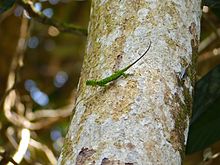
Draco cornutus is a species of "flying dragon", an agamid lizard. It is endemic to Borneo. It occurs at elevations up to 700 m (2,300 ft) above sea level, although its distribution is poorly known. (Full article...) -
Image 13
The gold dust day gecko (Phelsuma laticauda) is a diurnal species of gecko. It lives in northern Madagascar, the Comoro Islands, and the Mascarene Islands; it has also been introduced to Hawaii and other Pacific islands. It is primarily an arboreal species which can be found in tropical forests and may also associate with human dwellings. The gold dust day gecko feeds on insects and nectar.
One subspecies is recognized (in addition to the nominate one): Phelsuma laticauda angularis. (Full article...) -
Image 14
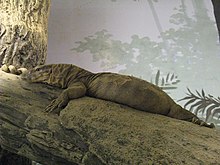
The yellow monitor (Varanus flavescens) or golden monitor is a monitor lizard native to South Asia. (Full article...) -
Image 15

The clouded monitor (Varanus nebulosus) is a species of monitor lizard, native to Burma, Thailand and Indochina to West Malaysia, Singapore, Java, Sumatra, and Vietnam. They are excellent tree climbers. It belongs to the subgenus Empagusia along with the Bengal monitor, the Dumeril's monitor and other monitor lizards. It had previously been listed as a subspecies of Bengal monitor by some herpetologists. It is a diurnal monitor. (Full article...) -
Image 16
The tokay gecko (Gekko gecko) is a nocturnal arboreal gecko in the genus Gekko, the true geckos. It is native to Asia and some Pacific Islands. (Full article...) -
Image 17

The Indo-Pacific gecko (Hemidactylus garnotii), also known commonly as Garnot's house gecko, fox gecko, and the Assam greyish brown gecko, is a species of lizard in the family Gekkonidae. The species is found in India, across Southeast Asia, Australia, and throughout Polynesia. Adults are about 4 to 5 in (10 to 13 cm) in total length (including tail). They are seen as dark gray or brown with light markings in daylight and a pale, translucent colour at night. The belly is orange or yellow. The head has a long, narrow snout, hence the name fox gecko. The flattened tail has a row of spiny scales on the lateral edges. The species is parthenogenic – all individuals are female and lay eggs that hatch without requiring male fertilisation.
In Hawaii, the species is thought to be a long-term resident. Formerly considered a house gecko, it has been displaced to natural habitats by the more recently arrived common house gecko. In Florida and Georgia, it has become established as an invasive species of concern. (Full article...) -
Image 18Hemidactylus is a genus of the common gecko family, Gekkonidae. It has 195 described species, newfound ones being described every few years. These geckos are found in all the tropical regions of the world, extending into the subtropical parts of Africa and Europe. They excel in colonizing oceanic islands by rafting on flotsam, and are for example found across most of Polynesia. In some archipelagoes, cryptic species complexes are found. Geckos like to live in and out of houses. They have been introduced to many areas around the world.
This species is closely related to the genus Gehyra, which belongs to the same family in Gekkonidae.
The species are typically known as house geckos, due to their readiness to adapt to and coexist with humans, and can be easily encountered in human habitations. (Full article...) -
Image 19
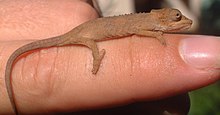
Setaro's dwarf chameleon (Bradypodion setaroi) is a species of lizard in the family Chamaeleonidae. (Full article...) -
Image 20
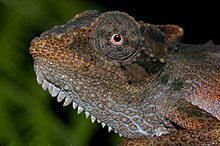
The Zululand dwarf chameleon (Bradypodion nemorale) is a species of lizard in the family Chamaeleonidae. It is also known as the Qudeni dwarf chameleon.
It is endemic to South Africa. (Full article...) -
Image 21

The Knysna dwarf chameleon (Bradypodion damaranum) is a species of dwarf chameleon in the Bradypodion ("slow footed") genus that is endemic to South Africa. It is a forest dweller, found only in a limited range in the afromontane forests near Knysna, South Africa, and in certain surrounding areas. (Full article...) -
Image 22
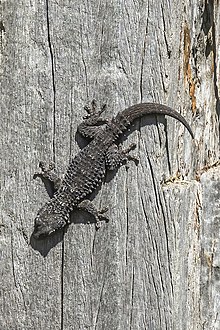
Tarentola mauritanica, known as the common wall gecko, is a species of gecko (Gekkota) native to the western Mediterranean area of North Africa and Europe. It has been introduced to Madeira and Balearic Islands, and the Americas (in Montevideo, Buenos Aires and California). A nocturnal animal with a predominantly insectivorous diet, it is commonly observed on walls in urban environments in warm coastal areas; it can be found further inland, especially in Spain where it has a tradition of cohabitation with humans as an insect hunter. A robust species, up to 15 centimetres (5.9 in) long, its tubercules are enlarged and give the species a spiny armoured appearance.
The species was first described by Carl Linnaeus in 1758. It is also known as moorish gecko, crocodile gecko, European common gecko, and, regionally, as osga (in Portuguese), salamanquesa (in Spanish) and dragó (in Catalan). (Full article...) -
Image 23
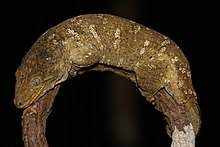
Rhacodactylus leachianus, commonly known as the New Caledonian giant gecko, Leach's giant gecko, leachianus gecko, or Leachie, is the largest living species of gecko and a member of the family Diplodactylidae. It is native to most of New Caledonia. (Full article...) -
Image 24
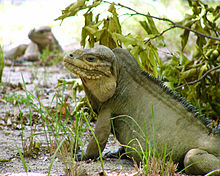
The Mona ground iguana (Cyclura stejnegeri) is a critically endangered species of rock iguana, endemic to Mona Island, Puerto Rico. It is one of the island nation's few large land animals, and it is the largest endemic terrestrial lizard in the country, and one of the biggest rock iguanas within the Antilles. It was previously considered a subspecies of the rhinoceros iguana (Cyclura cornuta). (Full article...) -
Image 25
Draco dussumieri, also known commonly as the Indian flying lizard, the southern flying lizard, and the Western Ghats flying lizard, is a species of lizard in the family Agamidae. The species is capable of gliding from tree to tree. It is found principally in the Western Ghats and some other hill forests of Southern India. It is almost completely arboreal, found on trees in forests and adjoining palm plantations where it climbs trees to forage for insects and glides to adjoining trees by expanding the patagium, loose skin on the sides of the body which is supported by elongated ribs to act as wings. The skin on the sides of the neck is also extended to the sides using the hyoid bones of the tongue as support. During the breeding season males maintain small territories which they defend from other males while courting females. The male has a more colourful patagium than the female, and it prominently extends its yellow dewlap forward in display. Although living almost its entire life in trees, the female descends to the ground to lay eggs in soil. This is the species with the westernmost distribution within the genus Draco, the majority of species occurring in Southeast Asia. (Full article...)
Selected turtle articles
-
Image 1

The Colombian wood turtle (Rhinoclemmys melanosterna) is one of nine species of turtle belonging to the genus Rhinoclemmys of the family Geoemydidae. It is found in Colombia, Ecuador, and Panama. (Full article...) -
Image 2

Leith's softshell turtle (Nilssonia leithii) is a species of turtle in the family Trionychidae. The species is found in peninsular Indian rivers including the Thungabhadra, Ghataprabha, Bhavani, Godavari, Kaveri and Moyar Rivers. The type locality is Pune in India. (Full article...) -
Image 3

Parker's snake-necked turtle (Chelodina parkeri) is a species of turtle in the family Chelidae. (Full article...) -
Image 4

The red side-necked turtle (Rhinemys rufipes), red turtle, red-footed sideneck turtle, William's toadhead turtle, or red-footed Amazon side-necked turtle is a monotypic species of turtle in the family Chelidae. It is found in Brazil, Colombia, and possibly Peru. (Full article...) -
Image 5

The Senegal flapshell turtle (Cyclanorbis senegalensis) is a species of turtle in the subfamily Cyclanorbinae of the family Trionychidae. The species, which is one of two species of softshell turtles in the genus Cyclanorbis, is endemic to Africa. (Full article...) -
Image 6

The Gulf Coast spiny softshell turtle (Apalone spinifera aspera), a subspecies in the Trionychidae family of softshell turtles, is endemic to the south-eastern United States. (Full article...) -
Image 7A green sea turtle swimming above a Hawaiian coral reef
The green sea turtle (Chelonia mydas), also known as the green turtle, black (sea) turtle or Pacific green turtle, is a species of large sea turtle of the family Cheloniidae. It is the only species in the genus Chelonia. Its range extends throughout tropical and subtropical seas around the world, with two distinct populations in the Atlantic and Pacific Oceans, but it is also found in the Indian Ocean. The common name refers to the usually green fat found beneath its carapace, due to its diet strictly being seagrass, not to the color of its carapace, which is olive to black.
The dorsoventrally flattened body of C. mydas is covered by a large, teardrop-shaped carapace; it has a pair of large, paddle-like flippers. It is usually lightly colored, although in the eastern Pacific populations, parts of the carapace can be almost black. Unlike other members of its family, such as the hawksbill sea turtle, C. mydas is mostly herbivorous. The adults usually inhabit shallow lagoons, feeding mostly on various species of seagrasses. The turtles bite off the tips of the blades of seagrass, which keeps the grass healthy.
Like other sea turtles, green sea turtles migrate long distances between feeding grounds and hatching beaches. Many islands worldwide are known as Turtle Island due to green sea turtles nesting on their beaches. Females crawl out on beaches, dig nests, and lay eggs during the night. Later, hatchlings emerge, and scramble into the water. Those that reach maturity may live to 90 years in the wild. (Full article...) -
Image 8
McCord's box turtle (Cuora mccordi) is a species of turtle in the family Geoemydidae. The species is native to China. (Full article...) -
Image 9
The brown wood turtle or brown land turtle (Rhinoclemmys annulata) is a species of turtle in the family Geoemydidae. The species is endemic to Central America and northern South America. (Full article...) -
Image 10

The Arizona mud turtle (Kinosternon stejnegeri) is a species of mud turtle in the family Kinosternidae found in the deserts of Arizona (United States) and Sonora (Mexico). It is a semi-aquatic turtle. It lives in impermanent puddles, and avoids permanent rivers and lakes.
The male adult Arizona mud turtle is 103–181.3 mm (4.06–7.14 in) long, and the female is slightly smaller. The turtle's top shell is brown and olive brown with a dome shaped appearance. The skin is brown, dark silver on top, and light yellow on bottom of the head. There are no patterns on the extremities.
The turtle's diet includes frogs, tadpoles, invertebrates and carrion. During winter the Arizona mud turtle hibernates under the temporary puddle and pond. (Full article...) -
Image 11

The Chinese softshell turtle (Pelodiscus sinensis) is a species of softshell turtle that is native to mainland China (Inner Mongolia to Guangxi, including Hong Kong) and Taiwan, with records of escapees—some of which have established introduced populations—in a wide range of other Asian countries, as well as Spain, Brazil and Hawaii.
Populations native to Northeast China, Russia, Korea and Japan were formerly included in this species, but are now regarded as separate as the northern Chinese softshell turtle (P. maackii). Furthermore, localized populations in Guangxi and Hunan (where the Chinese softshell turtle also is present), as well as Vietnam, are recognized as the lesser Chinese softshell turtle (P. parviformis) and Hunan softshell turtle (P. axenaria).
The Chinese softshell turtle is a vulnerable species, threatened by disease, habitat loss, and collection for food such as turtle soup. Additionally, millions are now farmed, especially in China, to support the food industry, and it is the world's most economically important turtle. (Full article...) -
Image 12
The yellow-blotched map turtle (Graptemys flavimaculata), or yellow-blotched sawback, is a species of turtle in the family Emydidae. It is part of the narrow-headed group of map turtles, and is endemic to the southern United States. (Full article...) -
Image 13

Pelodiscus maackii, commonly known as the Amur softshell turtle or the northern Chinese softshell turtle, is a species of turtle in the family Trionychidae. The species is found in the Russian Far East, northeastern China, Korea, and Japan. It is possible that the Japanese populations are the result of ancient introductions by humans. This aquatic species may attain a straight carapace length of 32.5 cm (1.1 ft). (Full article...) -
Image 14The African keeled mud turtle (Pelusios carinatus) is a species of turtle in the family Pelomedusidae.
It is endemic to central Africa : the Democratic Republic of the Congo, the Republic of the Congo, and Gabon. (Full article...) -
Image 15

Williams' mud turtle (Pelusios williamsi) is a species of turtle in the family Pelomedusidae. The species is endemic to Africa. (Full article...) -
Image 16

The African softshell turtle, or Nile softshell turtle (Trionyx triunguis), is a large species of softshell turtle from freshwater and brackish-water habitats in Africa (larger parts of Eastern, Northeastern, Western and Middle Africa) and the Near East (Israel, Lebanon, Syria and Turkey). It is the only extant species in the genus Trionyx; historically, despite other species having been formerly placed in this genus as well, they have all been reclassified to other genera.
Despite the common name of "African softshell turtle", Trionyx triunguis is not the sole species (or genus) of softshell turtle found in Africa—the genera Cyclanorbis and Cycloderma are African—nor is it solely found on that continent, alone. (Full article...) -
Image 17
Stone turtle on a fence post, a design in a park in Kunyang, Yunnan
Post turtle is a phrase that has been used in political discourse of various countries based on an old joke about the leader of a group being comparable to a turtle balanced on top of a fence post.
On Good Morning America in 1998, Hillary Clinton said "if you find a turtle on a fence post, it didn't get there by accident and I just look at the landscape around here and I see just lots of big old turtles sitting on lots of fence posts and I think we need to find out how those old turtles got on those fence posts."
Describing a person who is a post turtle, "You know he didn't get up there by himself, he doesn't belong up there, he doesn't know what to do while he's up there, he's elevated beyond his ability to function, and you just wonder what kind of dumb ass put him up there to begin with." (Full article...) -
Image 18
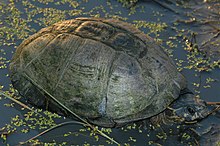
The Okavango mud turtle or Okavango terrapin) (Pelusios bechuanicus) is a species of turtle in the family Pelomedusidae endemic to Africa. It is found in Angola, Botswana, the Democratic Republic of the Congo, Namibia (Caprivi), Zambia, and Zimbabwe. (Full article...) -
Image 19

The Yunnan box turtle (Cuora yunnanensis) is a species of turtle in the family Geoemydidae (formerly Bataguridae). It is believed to be endemic to Yunnan, China (in Kunming and Huize) and was suspected to be extinct since the early 20th century; the last verified specimen was collected in 1940.
In 2004, a living female appeared from the pet trade in Kunming; one year later, a male from the same source and again one year later another female were found there. The validity of these specimens was doubted and many believed they were intentionally produced hybrids, a common technique in China to produce turtles that get high prices.
In 2007, He et al. sampled the three living specimens and gave the genetic proof that all three living specimens are indeed C. yunnanensis and not hybrids. In 2008, Kadoorie Conservation China, a department of Kadoorie Farm and Botanic Garden, together with the Kunming Institute of Zoology and Chinese Academy of Sciences, discovered a small wild population. The distribution of this species remains unclear, but due to its value, it is heavily sought after. Protection measures are needed to save this probably highly endangered species from its return onto the IUCN list of extinct animals. (Full article...) -
Image 20

The Big-headed Amazon River turtle (Peltocephalus dumerilianus), also known as the big-headed sideneck, is a species of turtle in the family Podocnemididae. (Full article...) -
Image 21Black-knobbed map turtle at Columbus Zoo and Aquarium
The black-knobbed map turtle (Graptemys nigrinoda), formerly known as the black-knobbed sawback, is a small to medium-sized aquatic turtle with light gray skin. Some of the most distinguishing characteristics of the black-knobbed map turtle, and the Graptemys genus, are the protruding "spikes" on the turtle's carapace. This species inhabits mainly the fall lines of rivers in the Mobile Bay drainage, in Alabama and Mississippi. (Full article...) -
Image 22Pond turtle may refer to:
- Emydidae, a family of pond turtles
- Emys, a genus of Emydidae
- European pond turtle (Emys orbicularis)
- Sicilian pond turtle (Emys trinacris)
- Western pond turtle (Actinemys marmorata or Emys marmorata)
- Emys, a genus of Emydidae
- Giant Asian pond turtle (Heosemys grandis)
- Mauremys, a genus of pond turtles
- Chinese pond turtle (Mauremys reevesii)
- Japanese pond turtle (Mauremys japonica)
- Philippine forest turtle or Leyte pond turtle (Heosemys leytensis)
- Emydidae, a family of pond turtles
-
Image 23Lithograph from 1878
The Burmese eyed turtle (Morenia ocellata), also known as the Bengal eyed terrapin, Burmese peacock turtle or swamp turtle, is a species of turtle in the family Geoemydidae of southern Asia. (Full article...) -
Image 24The spotted box turtle (Terrapene nelsoni) is a species of turtle in the family Emydidae. The species is endemic to the Sierra Madre Occidental in Mexico. (Full article...)
-
Image 25
The western swamp turtle or western swamp tortoise (Pseudemydura umbrina) is a critically endangered species of freshwater turtle endemic to a small portion of Western Australia. It is the only member of the genus Pseudemydura in the monotypic subfamily Pseudemydurinae.
It is the sister taxon to the subfamily Chelodininae. As a consequence of the greatly altered habitat in the area in which it occurs near Perth, Western Australia, it exists in small fragmented populations, making the species critically endangered. (Full article...)
Selected pictures
-
Image 1Gold dust day gecko close-up
-
Image 2Carolina anole
-
Image 3Asian vine snake Ahaetulla prasina. This snake has a wide distribution in Asia. It feeds on small reptiles and amphibians, particularly lizards and tree frogs. Adults may attain 1.8 m (6 feet) in total length, with a tail 0.6 m (2 feet) long. Its appearance is very much like those of South American vine snakes. It is a rear-fanged species and is mildly venomous but is not considered a threat to humans.
-
Image 4Yacare caiman
-
Image 5Phelsuma grandis
-
Image 7Trachylepis striata
-
Image 8Eastern bearded dragon
-
Image 9Leiocephalus personatus
-
Image 10Sinai agama
-
Image 11Leiocephalus carinatus
-
Image 12Steneosaurus
-
Image 13Gold dust day gecko
-
Image 14Species of Ceratopsia dinosaurs
-
Image 15Trachylepis maculilabris mating
-
Image 16Vipera xanthina
-
Image 17Vipera dinniki
-
Image 18Red-headed Amazon River turtles
-
Image 19Common box turtle
-
Image 20Gold dust day gecko
-
Image 21Australian water dragon
-
Image 22Plestiodon fasciatus
-
Image 23Thamnophis elegans terrestris at Western terrestrial garter snake
-
Image 24An Eastern long-necked turtle (Chelodina longicollis) covered in algae, in Victoria, Australia.
-
Image 25Common collared lizard
-
Image 26Namaqua chameleon
-
Image 27Ladder snake
-
Image 28Sicilian wall lizard
-
Image 29Anole at Polychrotinae
-
Image 30Indian chameleon
-
Image 31Mwanza flat-headed rock agama
-
Image 32Green sea turtle
-
Image 33Dwarf yellow-headed gecko
-
Image 34Barracudasauroides
-
Image 35Mexican beaded lizard
-
Image 36Bosc's fringe-toed lizards during courtship
-
Image 37Marine iguana
-
Image 38White-headed dwarf gecko
-
Image 39Green sea turtle (Chelonia mydas), Hawaiian Islands. Ninety percent of the Hawaiian green turtle population, known locally as honu, breed and nest at French Frigate Shoals, from April to November. Males apparently make the journey every year, while females make it at two to four year intervals. They are the subject of eco-tourism and has become something of a state mascot.
-
Image 40Jackson's chameleon
-
Image 41Bothriechis schlegelii
-
Image 42Italian wall lizard
-
Image 43Rough chameleon
-
Image 44Niveoscincus metallicus
-
Image 45Namaqua chameleon
-
Image 46Green sea turtle
-
Image 47Cerastes cerastes
-
Image 48The plumed basilisk (Basiliscus plumifrons) is a species of lizard native to Latin America. They are omnivorous and will eat insects, small mammals (such as rodents), smaller species of lizards, fruits and flowers.
-
Image 49Morelia spilota
-
Image 50A baby marginated tortoise hatchling emerges from its shell.
-
Image 51Aldabra giant tortoise
-
Image 52A green sea turtle swimming above a coral reef.
-
Image 53Cape skink - Trachylepis capensis. Close-up on purple Aster flowers.
Selected snake articles
-
Image 1

Cerastes vipera, common names Sahara sand viper and Avicenna viper, is a viper species endemic to the deserts of North Africa and the Sinai Peninsula. No subspecies are currently recognized. Like all other vipers, it is venomous. (Full article...) -
Image 2Tree snake is a common name for several snakes and may refer to:
- Boiga irregularis, the brown tree snake, native to Australia, Indonesia, and New Guinea, and notable as an invasive species in Guam
- Dendrelaphis, a genus of snakes known as "tree snakes" in Australia
- Imantodes, a genus of snakes native to Central and South America
-
Image 3Montane egg-eating snake
(Dasypeltis atra)
Dasypeltis is a genus of colubrid snakes. It is one of only two taxonomic groups of snakes known to have adapted to feed exclusively on eggs (the other being the genus Elachistodon). Dasypeltis are non-venomous and found throughout the continent of Africa, primarily in forested or wooded habitats that are also home to numerous species of birds. (Full article...) -
Image 4Trimeresurus tibetanus, also commonly known as the Tibetan bamboo pit viper and the Tibetan pit viper, is a species of venomous pit viper in the family Viperidae. The species is found only in Tibet. There are no subspecies that are recognized as being valid. (Full article...)
-
Image 5
Elaphe quadrivirgata, commonly known as the Japanese four-lined ratsnake or the Japanese striped snake (Japanese: shimahebi = striped snake), is a species of non-venomous colubrid snake native to Japan. (Full article...) -
Image 6
The tiger snake (Notechis scutatus) is a large and highly venomous snake of southern Australia, including its coastal islands and Tasmania. These snakes are often observed and locally well known by their banding, black and yellow like a tiger, although the species can be highly variable in colouration and patterning. All populations are classified within the genus Notechis (Elapidae). Their diverse characteristics have been classified either as distinct species or by subspecies and regional variation.
While tiger snakes are usually ground-dwelling, they are able to swim as well as climb into trees and buildings. (Full article...) -
Image 7Aesculapian snake (Zamenis longissimus)
Rat snakes are members – along with kingsnakes, milk snakes, vine snakes and indigo snakes – of the subfamily Colubrinae of the family Colubridae. They are medium to large constrictors and are found throughout much of the Northern Hemisphere. They feed primarily on rodents. Many species make attractive and docile pets and one, the corn snake, is one of the most popular reptile pets in the world. Like all snakes, they can be defensive when approached too closely, handled, or restrained. However, rat snake bites are not dangerous to humans. Like nearly all colubrids, rat snakes pose no threat to humans. Rat snakes were long believed to be completely nonvenomous, but recent studies have shown that some Old World species do possess small amounts of venom, though the amount is negligible relative to humans.
Previously, most rat snakes were assigned to the genus Elaphe, but many have been since renamed following mitochondrial DNA analysis performed in 2002. For the purpose of this article, names will be harmonized with the TIGR Database. (Full article...) -
Image 8
Echis (common names: saw-scaled vipers, carpet vipers) is a genus of vipers found in the dry regions of Africa, the Middle East, India, Sri Lanka and Pakistan. They have a characteristic threat display, rubbing sections of their body together to produce a "sizzling" warning sound. The name Echis is the Latin transliteration of the Greek word for "viper" (ἔχις). Like all vipers, they are venomous. Their common name is "saw-scaled vipers" and they include some of the species responsible for causing the most snakebite cases and deaths in the world. Twelve species are currently recognized. (Full article...) -
Image 9

The Sumatran short-tailed python (Python curtus) is a species of the family Pythonidae, a nonvenomous snake native to Sumatra. (Full article...) -
Image 10
The Aruba Island rattlesnake (Crotalus unicolor), is a venomous pit viper species endemic to the Caribbean island of Aruba, off the coast of Venezuela. It is sometimes still classified as a subspecies of Crotalus durissus. (Full article...) -
Image 11
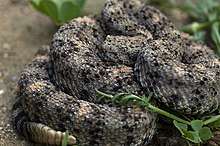
Crotalus pyrrhus is a venomous pitviper species found in the southwestern United States and northwestern Mexico. A medium-sized snake, it is found mostly in rocky country, active at night and feeding on small mammals. The coloration is variable and depends on the color of the rocks and soil of the habitat. (Full article...) -
Image 12
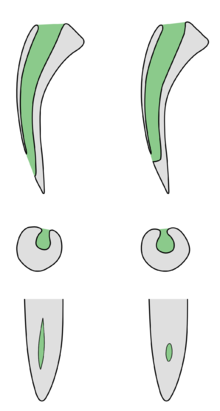
Schematic comparison between sections of non-spitting cobra fangs (left) and spitting (right).
1: Section of the whole fang in the sagittal plane.
2: Horizontal section through the fang at the discharge orifice.
3: Frontal view of the discharge orifices.
A "spitting" cobra is any of several species of cobra that can intentionally, defensively shoot their venom directly from their fangs. This substance has two functions, with the first being as venom that can be absorbed via the victim’s eyes, mouth, or nose (or any mucous membrane or existing wound), and secondly as a toxungen, which can be sprayed on the target surface. Their ability to target and shoot venom is utilised in several different ways, self-defense being the most common instance. Studies have shown that the targets (at which the cobras shoot) are far from random; rather, spitting cobras consciously take aim, directing their spray as close as possible to the eyes and face of an aggressor. (Full article...) -
Image 13

Hydrodynastes gigas is a New World species of large, rear-fanged, Dipsadin snake endemic to South America. It is commonly and alternatively known as the false water cobra and the Brazilian smooth snake. The false water cobra is so named because when the snake is threatened it "hoods" as a true cobra (Naja species) does. Unlike a true cobra, though, it does not rear up, but remains in a horizontal position. No subspecies are currently recognized as being valid. (Full article...) -
Image 14

Bothriechis schlegelii, known commonly as the highland eyelash-pitviper or Schlegel's eyelash-pitviper, is a species of pit viper in the family Viperidae, native to Colombia. Somewhat small, arboreal snakes, B. schlegelii is perhaps best known for the namesake superciliary ("eyelash") scales above its eyes, and for having distinctly keeled or "raised" scales covering the bulk of its body. The species is also known for producing a veritable rainbow of color forms (morphs). It is the most common of the green palm-pitvipers (genus Bothriechis), and is often present in zoological exhibits, owing to its general hardiness. The specific name schlegelii honors Hermann Schlegel, who was a German ornithologist and herpetologist.
For other common names, see below. No subspecies are currently recognized as being valid. (Full article...) -
Image 15
The yellow-bellied sea snake (Hydrophis platurus) is a venomous species of snake from the subfamily Hydrophiinae (the sea snakes) found in tropical oceanic waters around the world except for the Atlantic Ocean. For many years, it was placed in the monotypic genus Pelamis, but recent molecular evidence indicates it lies within the genus Hydrophis. (Full article...) -
Image 16Porthidium nasutum,
rainforest hognose pitviper
Porthidium is a genus of pit vipers found in Mexico and southward to northern South America. The name is derived from the Greek word portheo and the suffix -idus, which mean "destroy" and "having the nature of", apparently a reference to the venom. As of August 2016 nine species are recognized as being valid. The snakes of the genus Hypnale in southern India and Sri Lanka look quite similar to those of this genus, possibly an example of convergent evolution. (Full article...) -
Image 17
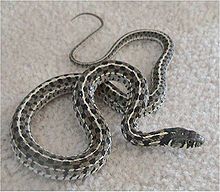
The checkered garter snake (Thamnophis marcianus) is a species of garter snake in the subfamily Natricinae of the family Colubridae. The species is endemic to the southwestern United States, Mexico, and Central America. (Full article...) -
Image 18

Deinagkistrodon is a monotypic genus created for the pit viper species, Deinagkistrodon acutus, which is endemic to Southeast Asia. No subspecies are currently recognized. (Full article...) -
Image 19Hebius modestus, commonly known as the modest keelback or Günther's keelback, is a species of natricine snake endemic to Asia. (Full article...)
-
Image 20
The Acrochordidae, commonly known as wart snakes, Java wart snakes, file snakes, elephant trunk snakes, or dogface snakes are a monogeneric family created for the genus Acrochordus. This is a group of basal aquatic snakes found in Australia and tropical Asia. Currently, three species are recognized. (Full article...) -
Image 21

Bothriechis rowleyi is a species of pit viper, a venomous snake, in the subfamily Crotalinae of the family Viperidae. The species is endemic to Mexico. There are no subspecies that are recognized as being valid. (Full article...) -
Image 22

Euprepiophis conspicillata, commonly known as the Japanese forest rat snake, is a species of nonvenomous colubrid snake endemic to Japan. Its Japanese common name, jimuguri, roughly translates to "the burrower". It is closely related to Euprepiophis mandarinus, the Mandarin rat snake. (Full article...) -
Image 23
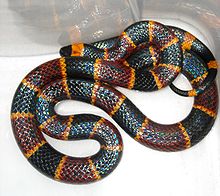
Micrurus fulvius, commonly known as the eastern coral snake, common coral snake, American cobra, and more, is a species of highly venomous coral snake in the family Elapidae. The family also contains the cobras and sea snakes. The species is endemic to the southeastern United States. It should not be confused with the scarlet snake (Cemophora coccinea) or scarlet kingsnake (Lampropeltis elapsoides), which are harmless mimics. No subspecies are currently recognized. (Full article...) -
Image 24
The rough-scaled python (Morelia carinata) is a large-scaled python species endemic to Australia. No subspecies are currently recognized. (Full article...) -
Image 25

Indotyphlops braminus, commonly known as the brahminy blind snake and other names, is a non-venomous blind snake species, found mostly in Africa and Asia, and has been introduced in many other parts of the world. It is a completely fossorial (i.e., burrowing) reptile, with habits and appearance similar to an earthworm, for which it is often mistaken, although close examination reveals tiny scales and eyes rather than the annular segments characteristic of a true earthworm. The species is parthenogenetic and all known specimens have been female. The specific name is a Latinized form of the word Brahmin. No subspecies are currently recognized as being valid. (Full article...)
Categories
Associated Wikimedia
The following Wikimedia Foundation sister projects provide more on this subject:
-
Commons
Free media repository -
Wikibooks
Free textbooks and manuals -
Wikidata
Free knowledge base -
Wikinews
Free-content news -
Wikiquote
Collection of quotations -
Wikisource
Free-content library -
Wikiversity
Free learning tools -
Wiktionary
Dictionary and thesaurus




